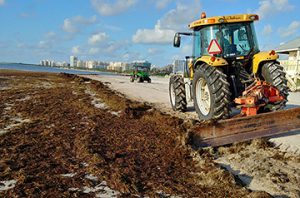
What is Sargassum?
Sargassum is a macroalgae, or seaweed, that originates in the Sargasso Sea, off of the east coast of the United States in the North Atlantic Ocean. The two species of sargassum are Sargassum natans and Sargassum fluitans, which are both recognizable by their brown color and tiny grape-like features, which are small bubbles that are used by the algae to regulate their ability to float. These free-floating algae drift on the ocean’s surface, traveling with wind action and current. Sargassum and other seaweeds are highly beneficial to the natural state of South Florida beaches. Among other services, they provide habitat for endangered sea turtles, hiding places for crabs and other invertebrates, and food sources for birds. Sargassum also provides nutrients to the shoreline and beach sand, and can help replenish areas that suffer beach erosion due to hurricanes and storms.
Why is there so much of it?
Although the Sargasso Sea is quite far away from Florida, we locals become very familiar with this seaweed every summer. Because most of South Florida’s beaches are in close proximity to the strong currents of the Gulf Stream, many things wash onto the shore, including sargassum. This naturally accumulates on beaches, but can increase due to severe weather, high temperatures, wind, and changes in tides. Sargassum production fluctuates seasonally and tends to be higher in the later spring and early summer months. However, over the course of this summer, the level of sargassum accumulation has been much higher than normal. The seaweed has been piling up in massive amounts on our local beaches, as well as the coast of Texas and the Caribbean. Even though the seaweed originates in the Sargasso Sea, warm water, sunlight, and higher nutrient levels can increase its growth rates. Not only do these major influxes of sargassum clog up our beaches, but they can also over shade bottom marine ecosystems such as seagrasses and corals, essentially smothering their ability to photosynthesize.
Sargassum tends to accumulate on the shoreline, often brought in at high tide. Depending on the slope of the shoreline and water depth, the seaweed will leave with the outgoing tide. However, on beaches that are extremely shallow, such as Crandon Park here in Miami-Dade County, the sargassum arrives at high tide and stays put, continuing to pile up with each high tide, twice a day. The result is a massive carpet of algae that begins to decay under the strong rays from the summer sun. As the seaweed begins to break down, it becomes slimy and emits an unpleasant odor. These factors, compiled with difficulty in physically accessing the beach have hurt local tourism this summer.
How is it managed?
Crandon Park Manager Danny Barcia was nice enough to show me how the Park staff manage the sargassum deposits. Their standard practice is called “blading,” where a tractor equipped with a shovel-like apparatus runs north and south along the beach, pushing the piles of sargassum eastward, into the water. This practice is limiting for several reasons: staff must have completed special training to operate this machine (currently, there are only two staff members qualified to do this), sea turtle regulations limit the depth that can be impacted by the front loader, and the tractor itself can only perform when it has a surface hard enough to hold its weight. As the tractor gets closer to the water line, the sand becomes softer and there is a risk of the tractor becoming stuck.
Crandon Park was granted a temporary permit from the Florida Department of Environmental Protection for another removal method: to use a front loader to scoop sargassum and move it to a pile located above the wrack line. This is a permitted activity because it physically removes the organic material from the area, and with that, potentially hidden marine life. Since the rate of accumulation has been so intense this year, this has been a permitted activity at Crandon Park. Similar limitations exist for the front-loader removal as with the blading, as well as that the front-loader operator must take one extra step after the work is done: go back with the blade to remove the tire ruts created by the front loader, as these can become navigation hazards for baby sea turtles during sea turtle nesting season. All of the work is performed during low tide and/or the early morning hours. Other removal methods are dependent on the city or municipality:
- City of Hallandale Beach crews clear the beach by piling the seaweed farther from the water for it to disintegrate.
- City of Hollywood crews remove trash from the seaweed before using two tractor machines with blades to mix the seaweed with the sand and bury it at the high tide line. This is practiced in most Broward County cities, including Dania and Pompano Beach.
- The City of Deerfield Beach uses one tractor to clear its mile-long beach. The tractor drives along the beach collecting sargassum and then deposits it into a dumpster. The dumpster is then transported and emptied at a waste management facility.
- The City of Fort Lauderdale is the only other Broward city that hauls away the seaweed. On heavy accumulation days, the city’s crews load more than 70 cubic yards into at least eight dump trucks. These are brought to a facility where they clean off the salt water and compost it into soil. The compost is eventually used in city parks and on road medians.
- City of Miami Beach sargassum is managed by Miami-Dade County Parks, Recreation, and Open Spaces staff. The management strategies are the same as what Crandon Park employs; however, since Miami Beach has deeper water, the accumulation levels are not as bad as at Crandon Park. Most of the sargassum washes back out to sea with the high tide.
- At beaches in State Parks, seaweed is left untouched.
 0
0
